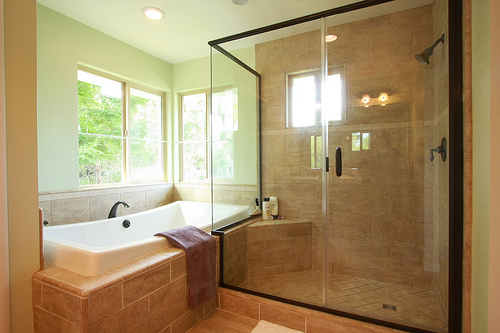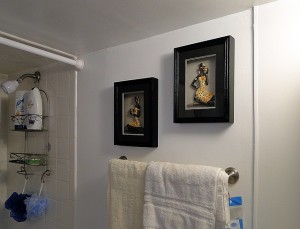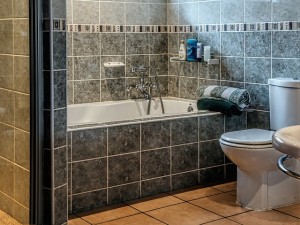Bathroom remodeling ideas are always a helpful item to have around. When you are investing in a remodeling project, you surely want the results to not only please you but to add value to your home. It could even save you money on electricity and water as well. These few steps might help you to take advantage of the latest design trends, technologies and products.
Budget for the unexpected
Hidden water damage is one of the most common problems in bathrooms. It could be a leaky shower pan or running toilet that is wreaking havoc on your floor. If it feels spongy, it is a sign of serious water damage. Some other problems are truly hidden which could be a vent stack inside a wall you want to knock down.
Hide the toilet
A master bathroom that is both stylish and functional can also be very discreet. It is always nice to hide a toilet in a room within the bathroom, behind a half-wall or perhaps behind some sort of barrier or divider.
Choose appropriate surfaces,?h3>
The surfaces in your bathroom do a lot more than just contribute to aesthetics. They take a lot of abuse and for that, you need the right surfaces which can handle it. Porcelain is a favorite among designers, for use on the walls and floors alike. Some porcelain tiles are cheap at roughly R80 per square meter and resemble natural stone. If you want to ease the upkeep, you could use larger tiles to minimize grout lines.
Porcelain is also a popular choice for bathroom sinks but some tests have shown that they can chip when subjected to heavy impacts. Enamel-on-steel sinks are very durable and stain-resistant. Stainless steel sinks are also becoming more popular for use in the bathrooms as well. A solid-surface sink is another durable option and it allows you to integrate the sink with a vanity countertop.
When it comes to the countertop, granite and quarts have moved from the kitchen to the bathroom. It is very durable and visually pleasing. Laminated and solid surface sinks are still popular and cost-effective choices but it can scratch easy.
Spend on the shower
People have started to use bathtubs even less due to high water usage and efficiency. Nowadays people do not usually install baths in their homes and use the space to create bigger showers. This can be a big shower that has two showerheads, own storage areas and perhaps steam generators.
In order to create such a space, you roughly need a shower stall that is at least 1.2m (4 feet) by 1.8m (6 feet), larger than the standard 0.9m (3 feet) by 0.9m (3 feet) stall. If you can take the stall up to 1.5m (5 feet) by 2.1m (7 feet), you may even forget about installing a door because the showerheads can be directed in a way that the spray does not reach beyond the shower area. An L-shaped design is the best to use. This will eliminate a sizable expense, especially if you were planning on a frameless door. Just one thing to take note of: do NOT remove the bathtub if there are no more in the house.
Consider the water usage
Showerheads, toilets and faucets gave become more water-efficient in recent years due to water shortages and the price of water. Low-flow showerheads and faucets will save more water than the traditional fixtures. These water-efficient fixtures generally cost the same or are cheaper than the traditional fixtures. Some companies claim that their fixtures are 20% more water-efficient than the traditional ones.
As for toilets, the old fashioned one can use as much as 12 liters per flush, while new dual flush toilets use 6 liters for a full and 3 liters for a half. By using these dual flush toilets, you can save between 6 and 9 liters per flush, which ultimately reduces your utility bill. If you choose a faucet with an aerator, you can reduce the water flow in your bathroom sink by 30% or more.
Clear space on the vanity
Since grooming is the main task at the vanity, it is important to have plenty of surface are to put things down. Since a double sink has been popular in the past, it makes more sense to have a single sink with a lot of counter space. Not only does it take a lot less space, but a single vanity save you the expense of a second sink and faucet. By eliminating a set of plumbing, it expands the storage space inside the vanity as well.
Ensure adequate ventilation and light
Moisture does not only create mold and mildew, it can take a toll on finishes and painted surfaces. A bathroom fan or ventilation system is the best defense. A ducted system that is at least 50 cubic feet per minute is generally the international standard, but you might need twice as much ventilation if the space is larger than 10 square feet or if you have a steam shower. You can also consider installing a humidity-sensing unit that will automatically turn on and off, depending on the amount of moisture in the air.
As for lighting, the goal is to bring different layers of illumination into the bathroom. A ceiling fixture is suitable for general lighting, but it will cast shadows on your face when you are seated at the vanity or standing in front of the mirror. Wall scones or other vertical fixtures mounted on the sides of the vanity can eliminate the shadows. Some medicine cabinets are available with vertical light strips.
The shower, toilet or bathtub should also have a dedicated task light, such as a recessed canister light. LED bulbs are the best choice because they provide loads of light and they are more energy-efficient than ordinary bulbs. The only drawback is that these lights cost more than ordinary or energy-saving bulbs. Remember that you can put the fixtures on dimmer switches so that light levels can be adjusted according to the mood and task at hand.




